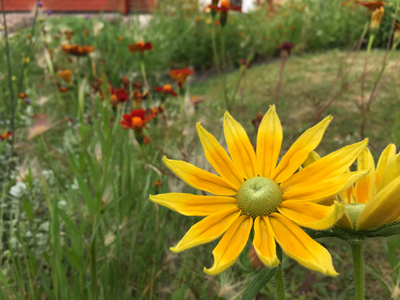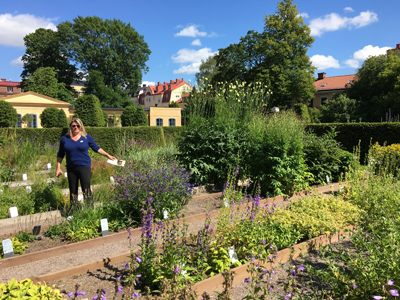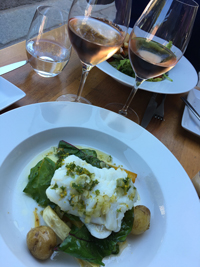What’s in a Name?
A visit to the garden of Carl Linnaeus
by Reynolds Kelly

Rudbeckia in Linnaeus’s country garden
It’s summer in upstate New York, and all our flowers are in bloom. Few are as appealing to me as blackeyed Susans. Some call them coneflowers, and they’re in the sunflower, or daisy family (Compositae): bright and cheerful. Horticulturists and botanists call them by the genus Rudbeckia. As a layperson, that name, like so many scientific names for plants, has always puzzled me. Rudbeckia? I never knew what it meant, but it sounded “rude” for such a friendly flower.
Turns out that the origin of that name goes back to the earliest days of botany as a science. Plants, of course, have been around forever. But the modern system of naming plants, binomial nomenclature, dates back to the mid-1700s in Sweden, and was the brainchild of botanist, physician, and zoologist Carl Linnaeus, the “Father of Modern Taxonomy.” Linnaeus started gardening as a boy, and Sweden’s climate is not unlike that of our own upstate growing season. In the 1720s, Linnaeus attended Uppsala University, about 50 miles north of the capital, Stockholm. By his second year he was selected to give lectures, a rare distinction for someone his age. After growing to doubt the common plant classification system then in wide use, Linnaeus went on to publish Systema Naturae. By the time Linnaeus published his twelfth edition in the 1750s, people sent specimens from all over the world for inclusion, and Linnaeus is credited with inventing the index card to keep track of his work.

Linneaus’s private, fireproof museum

Building with a sod roof in the country garden
As a successful botanist and physician in Uppsala, Linnaeus enjoyed a country estate (the Hammarby) and a city home, both with extensive gardens. Out in the country he constructed a private fireproof museum for his botanical specimens. He wasn’t about to risk losing the world’s most extensive collection to fire, as happened to his mentor years before. A stately home, with outbuildings for the needs of his household, embraced a formal garden. A turf roof offered not just more opportunity to grow plants, but protection from fire—a spark landing in a garden is less likely to burn your house down than one landing on dry wooden shingles.
While Linnaeus’s country estate offered beautiful botanical bliss, in town he was all business. Linnetradgarden—Swedish for “the Linnaeus Garden”— was and is a living laboratory of plants and flowers, all carefully designed by Linnaeus and maintained today by Uppsala University. All of the plants are known to have been grown by Linnaeus himself (he kept scrupulous records) and are organized by his Sexual System. There are careful distinctions between spring and autumn flowering plants, with separate sections for different aquatic ecosystems. The garden is a jewelbox of botany: No more than an acre, it is rich with specimens and alluringly organized.

UGJ publisher Jane Milliman in Linneaus’s town garden
But back to Rudbeckia. Naming seems to have been a fond hobby for Linnaeus. Born Carl Nilsson, he adopted the last name Linnaeus from a linden tree that grew out of an old stone heap on his father’s farm. When it came to naming the cheerful black-eyed Susan, Linnaeus chose the name of his longtime mentor at Uppsala University, botanist Otto Rudbeck. This time of the year, I see these flowers every day in my own garden, and think of Otto.
Lunch at Hambergs Fisk
IF YOU GO:
Stockholm is wonderful in summer. Nights are long and the city is easily traversed by bike (citybikes.se). Pedal through the Old Town of Gamla Stan, and head to B.A.R. for dinner (restaurangbar.se).Rent a car to explore Uppsala. Start with the Hammarby (botan.uu.se/our-gardens/Linnaeushammarby/), then head to the quaint university town center to see the Linnetradgarden (botan.uu.se/ourgardens/the-linnaeus-garden/). Stop for a relaxing lunch at Hambergs Fisk (hambergs.se), and be sure to sit outside along the banks of the River Fyris. Later you can drive to the outskirts to see ancient burial mounds at Gamla Uppsala, just a few miles out of town.
Views: 1





